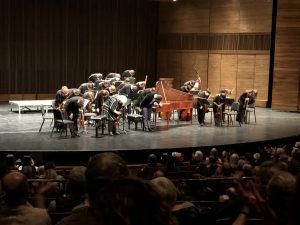by Vaidik Trivedi
News Editor
The Juilliard415 Historical Performance, held in the Peter Jay Sharp Theater at Lincoln Center, NYC on Jan 18, left the audience in an awe of how the Juilliard School butchered Wolfgang Amadeus Mozart’s melodious symphonies. Starring music pundits like Monica Huggett and David Belkovski, the musical ensemble failed to do justice to Mozart, one of the best classical musicians to ever walk the earth.

A lot of people may not know what a clarinet (type of flute) is, but are still familiar with the works of Mozart. Thus, performing a symphony composed by Mozart, for a wrinkled, grey-haired audience, can be a bit tricky. The young inept musicians of the prestigious Juilliard School did follow the lead of their concertmaster, Huggett, without missing a note, but failed to create the aura of a musical journey that an orchestra provides.
You might have seen hands and heads move in a synchronized pattern in an orchestra. Rarely will you find the musical ensemble changing their expression in unison. The musical protégé of the Juilliard School, striving towards perfection rehearsed to the point where every movement on stage, including their expressions, was muscle memory. But over-rehearsing made them look too stiff and mechanical. Following the bobbing white afro of their conductor, the musical group failed to impress the audience with their monochromatic faces and the lack of zeal in the performance. At some points, it felt like a lot of the musicians didn’t even want to be on stage and would rather play music for their pet at home.
The spectators in Peter Jay Theater remained silent during the performance but broke into applauses after the first 15-minute break, followed by soft murmurs from the audience. Waking some from their deep slumber, the murmurs soon turned into a wave of disapproving nods until David Belkovski took matters on his fingers (pun intended) and nailed the Piano Concerto no. 24 in C minor. The hall broke into a thunderous applause after a solo from the much-awaited artist and gave some pace to the concert.
The much-needed intermission split the 90-minute concert in two halves. The red carpeted floor was soon infested with heads shaking in disappointment. Some half-asleep spectators stumbled their way out of the hall in disgust, while others stayed behind for the meet-and-greet of their old friends suffering in the audience. Very few music enthusiasts stayed back to watch the finale.
The orchestra performed Symphony No. 41 in C Minor “Jupiter” as its finale which was much appreciated by audience. The orchestra played the symphony to the beat, but lacked the spirit of a musician. The rush of applauses by the polite audience was well-received by the young musicians and, for the first time, bright smiling faces could be seen on stage.
The performance was melodious to the ears but unpleasing to the eye. Mozart made symphonies to enjoy music and different instruments. But an instrument is only as good as the musician playing it. Matching difficult notes with perfection is half a job done. Spectators can listen to perfect notes at home or on the subway. A live performance is all about the how the musician can express music through himself. That’s what you pay the thunder bucks for.


